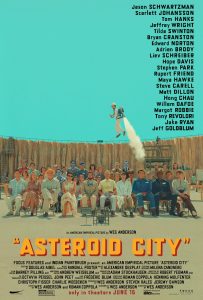Wes Anderson is an American director known for his particular style of filmmaking. From bright colors and quirky characters to wide camera shots with satisfying symmetry. Movies like one of his earliest films, Rushmore, or his most recent Asteroid City, are instantly recognized for their character and charm.

Although there are many perks to having such a recognizable approach to directing, in the more recent years his movies have become stuck in his style. In Asteroid City, characters feel more like caricatures than real people, and the main substance of the film gets lost in Anderson’s style and attempts at being meta.
In earlier movies, like Rushmore, Anderson’s directing was more muted, focused on the storytelling above all. The characters, their personalities and problems, and the conflict of the movie felt more real, relatable, and raw; I cared about the people in the movie.
Even though the story still showcased aspects of Anderson’s moviemaking, like the semi-ridiculous plotline and the eccentric characters, the style of Rushmore was still immature and did not overshadow Anderson’s storytelling. The movie had more heart.
This heart was not lost in The Royal Tenenbaums, but in later films, like Moonrise Kingdom and The Grand Budapest Hotel, Anderson slowly started to emphasize the stylization along with the plot line. It was not until The French Dispatch, however, where Anderson really started to ignore the nuances of plot and leaned in too deep into his stylization.
In Asteroid City, the Andersification of his storytelling has procured a film that is so focused on style that the movie itself seems like an excuse to film pretty colors in symmetrical shots with famous actors spitting witty line after witty line of dialogue.

Asteroid City is the telling of a play within a movie. The play follows Augie Steenback (Jason Schwartzman), a grieving father taking his teenage son, Woodrow (Jake Ryan), and three young daughters on a trip to the desert town Asteroid City for his son’s Junior Stargazing competition. After the town and junior stargazers are visited by an extraterrestrial lifeform, however, the government must intervene and hijinks ensue.
In the film, the plot bounces between a narration of the making of a play and the play itself. As the viewer, we get to see the play in movie form, existing as if it was real, but also the behind-the-scenes, as the actors and director navigate how to put on a show.
But Anderson’s framing of the story only confuses and distances the viewer from the characters–their personality, their stories, and their struggles.
Along with this, Anderson is so stuck in his classic stylization that the people in the film don’t feel alive. The way they speak, dress, and act is hyper-stylized, and makes their personalities and feelings seem fake. In Anderson’s more recent flics, his characters always act like characters, instead of like real people.
Any real substance explored in the making of the play, ideas of art, purpose, and uncertainty gets lost in translation. At times when watching the movie, I wasn’t sure if Anderson even understood what points he was making.
The play within Asteroid City itself was highly enjoyable and, if Anderson hadn’t framed the narrative as he did, would have made it an easy hit. The charm of the story or the quaint scenery and nods to western American culture all added up to create a cute story on family, curiosity, and–of course–extraterrestrial life.
Anderson, however, has become lost in his own Andersification of storytelling. He is more obsessed with the imagery of his movies, focusing more on the color pallets and camera shots while forgetting the basics of storytelling.
This stylization is becoming risky–Anderson is on the cusp of making a film that is completely self-indulgent and sacrificial of the art of storytelling. When his priority in a movie is sticking to his personal status quo of filmmaking, Anderson will start making films that no one wants to see.





Mr. St. John • Nov 17, 2023 at 8:09 am
Brava to Elaine Clarke for speaking her mind about the direction of Wes Anderson’s films. While I understand the reviewer’s complaint about the trajectory of Anderson’s work, I see it as his deliberate decision to make Art, not just movies. He is challenging the status quo. The unrealistic flatness of his characters is not a flaw in his directing but rather the whole point. Asking Anderson to not make one-dimensional characters is like asking Picasso to not make cubist portraits. Neither artist is aiming for realism in how they render people. Neither are looking to touch the viewer’s heart. Instead, they touch the mind by making us ponder an artistic question: what does it look like when we flatten reality? It’s not reality anymore when you render it as paint on canvas or as light on a silver screen. Neither artist pretends that it is, and both hope that the audience acknowledges that fact.
The reviewer will be relieved to know that most filmmakers probably do care deeply about creating characters that are, as the reviewer wants, “more real, relatable.” She notes RUSHMORE, an early Anderson film in which she “cared more about the people in the movie.” I did too. No argument there. However, as his projects have moved further and further from the mainstream, each addition to Anderson’s o’euvre reminds us more and more that “the people in the movie” are NOT actually people at all. The reviewer said that in Anderson’s recent films, “characters always act like characters, instead of like real people.” While she means that as a criticism, I think Wes Anderson would see it as a compliment. Finally people are realizing what he is trying to accomplish! They look like people, but they’re flat projections. It’s not reality; it’s Art.
On his realistically-rendered paintings of an apple and of a pipe, the groundbreaking artist named Rene Magritte wrote “Ceci n’est pas une pomme” and “Ceci n’est pas une pipe.” Translation: This is not an apple. This is not a pipe. He’s right of course. It’s not an apple. It’s a painting of an apple. It’s not a pipe. It’s a painting of a pipe. You can’t eat the former or smoke the latter because they are just paint on canvas. That’s Art.
Sometimes it’s realistic, sometimes it’s pretty, and sometimes it’s meant to make you question what is real. Augie Steenback is not real. He’s a character.
Unlike Magritte, Wes Anderson hasn’t done the thinking for us. His flat characters don’t come with a label that reads “This is not a person.” Still, I think he’d be happy to hear that the reviewer has realized that fact on her own.
Facts.
Francisco Aguirre-Ghiso • Oct 30, 2023 at 9:28 pm
fax